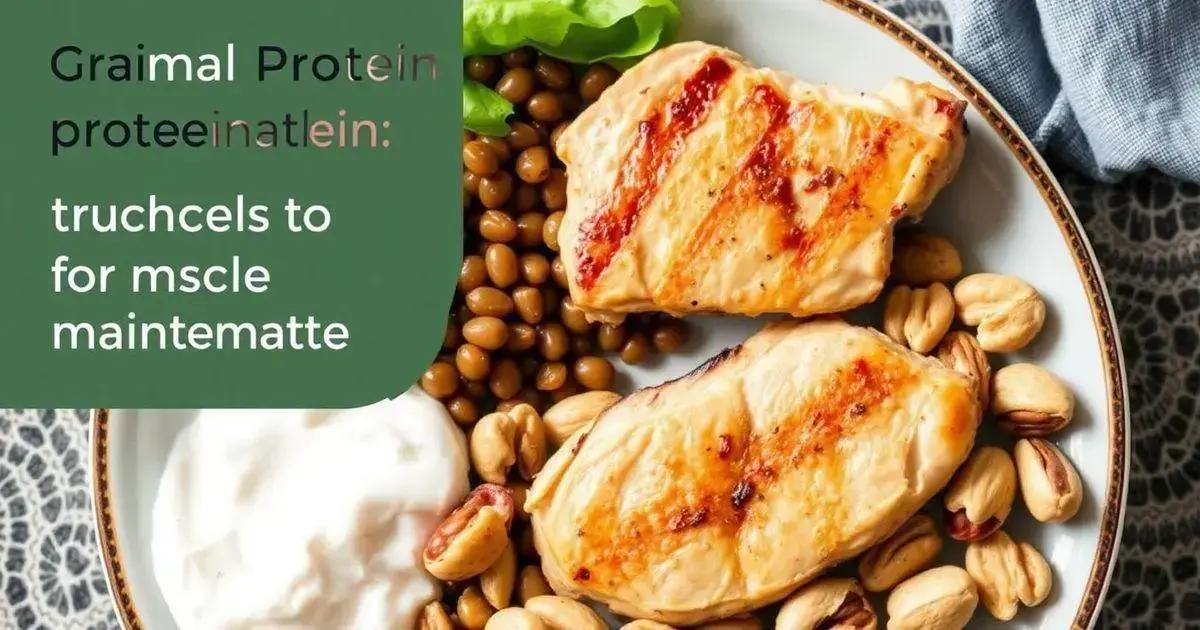To prevent loss of muscle tone, it is essential to maintain an adequate protein intake alongside regular exercise. Aim for a protein intake of 0.8 to 2.0 grams per kilogram of body weight, depending on your activity level, and incorporate strength training, HIIT, and flexibility exercises into your routine.
Are you concerned about losing muscle tone as you age? How to prevent loss of muscle tone with protein intake is an essential topic for maintaining strength and vitality. Muscle tone is important for overall health, and the right protein intake can play a crucial role in preserving it. In this article, we’ll explore how protein supports muscle maintenance, offer tips for optimal intake, and suggest exercises that will help you retain muscle tone effectively.
Understanding Muscle Tone and Its Importance

Understanding muscle tone is crucial for maintaining a healthy body. Muscle tone refers to the continuous and passive partial contraction of the muscles. In simple terms, it is the state of readiness of your muscles, which helps in maintaining posture and responding quickly to movement.
Having good muscle tone can enhance your physical appearance, give you strength, and improve your overall balance and coordination. It also plays an essential role in daily activities like climbing stairs or carrying groceries.
The Importance of Muscle Tone
Maintaining muscle tone is vital for several reasons. First, it helps in preserving muscle strength as you grow older. As we age, our bodies naturally lose muscle mass. This can lead to weaknesses, making everyday tasks more challenging.
Good muscle tone can also improve your metabolism. Muscles burn more calories than fat, even when at rest. This means that having a toned body can help in weight management and overall health.
Muscle Tone and Injury Prevention
In addition to strength and metabolism, proper muscle tone helps in injury prevention. Well-toned muscles provide better support for your joints. This can decrease the risk of falls and injuries during physical activities.
In conclusion, understanding and maintaining muscle tone is key to a healthier, more active lifestyle. From enhancing your appearance to preventing injuries, investing time in your muscle health can lead to significant benefits.
Role of Protein in Muscle Maintenance

The role of protein in muscle maintenance cannot be overstated. Protein is one of the essential building blocks of muscle tissue. When you engage in physical activity, especially strength training, your muscle fibers experience small tears. Protein helps repair these tears, leading to stronger and more toned muscles.
Consuming adequate protein is vital for muscle recovery and growth. It plays a significant role in the muscle protein synthesis process, which occurs after exercise. This process is how your body rebuilds and strengthens muscle fibers.
Types of Protein
There are two main types of protein: animal protein and plant protein. Animal proteins, such as chicken, fish, and dairy, typically contain all essential amino acids, making them complete proteins. Plant proteins, like beans, lentils, and quinoa, can also provide adequate protein but may need to be combined to ensure all essential amino acids are included.
For optimal muscle maintenance, it is crucial to include both types in your diet. This diverse approach ensures you receive a broad range of nutrients necessary for muscle health.
Protein Timing
The timing of protein intake is also important. Many experts recommend consuming protein within a 30-minute to two-hour window after exercising. This post-workout meal helps maximize muscle recovery and gains.
In addition to post-exercise protein intake, it is beneficial to spread your protein consumption throughout the day. Aim for a source of protein with each meal to support continuous muscle repair and growth.
Tips for Optimal Protein Intake

Optimal protein intake is essential for maintaining muscle tone and overall health. Here are some helpful tips to ensure you are getting the right amount of protein.
Know Your Protein Needs
First, it’s important to understand how much protein you need. The general recommendation is about 0.8 grams per kilogram of body weight. For athletes or those trying to build muscle, this can increase to 1.2 to 2.0 grams per kilogram. Use a simple calculator to determine your needs based on your goals and activity level.
Include a Variety of Protein Sources
Include a mix of protein sources in your diet to cover all essential amino acids. Animal proteins, such as meat, eggs, and dairy, can provide complete proteins. Meanwhile, plant proteins like beans, nuts, and whole grains can round out your nutrition.
Spread Your Protein Intake
Aim to spread your protein intake evenly throughout the day. Eating protein-rich foods at every meal can help maximize muscle protein synthesis. Try to have about 20-30 grams of protein in each meal to keep your muscles nourished.
Consider Protein Supplements
If you’re struggling to meet your protein needs through food alone, consider adding protein supplements. Whey protein and plant-based protein powders can be effective options. They are convenient and provide a quick source of protein, especially post-workout.
Monitor Your Progress
Keep track of your protein intake and how your body responds over time. If you are not seeing improvements in muscle tone or recovery, you may need to adjust your protein consumption.
Exercises to Complement Protein for Muscle Tone

Exercises to complement protein intake are essential for enhancing muscle tone. Engaging in regular physical activity helps utilize the protein you consume effectively. Here are some exercises that can help boost your results.
Strength Training
Strength training exercises are great for building muscle. Incorporate weight lifting, resistance bands, or bodyweight exercises into your routine. Focus on compound movements like squats, deadlifts, and bench presses, which work multiple muscle groups at once.
High-Intensity Interval Training (HIIT)
HIIT workouts can help increase muscle tone and burn fat. These workouts consist of short bursts of intense activity followed by rest periods. Examples include sprinting, jumping jacks, and burpees. HIIT can enhance your overall fitness level while complementing the protein intake.
Core Strengthening Exercises
Core exercises are crucial for stability and good posture. Include exercises like planks, Russian twists, and mountain climbers in your routine. A strong core supports all other muscle movements and helps maintain muscle tone.
Flexibility and Mobility Work
Don’t forget to work on your flexibility! Incorporating yoga or stretching routines can promote muscle recovery and prevent injuries. Keeping your muscles flexible aids in maintaining muscle tone over time.
Consistency is Key
To achieve the best results, maintain a consistent workout schedule. Aim for at least 150 minutes of moderate-intensity exercise per week, combining both cardio and strength training. Regular workouts, along with adequate protein intake, will greatly support muscle toning efforts.
In Summary: Maintaining Muscle Tone through Protein and Exercise
Maintaining muscle tone is essential for overall health and vitality. By understanding the importance of protein intake and pairing it with effective exercises, you can significantly enhance your muscle maintenance efforts.
Protein plays a vital role in muscle repair and growth, while exercises such as strength training, HIIT, and core workouts further support your goals. Always aim for a balanced diet rich in protein and engage in consistent physical activity to achieve the best results.
Remember, a holistic approach that includes proper nutrition and regular exercise will not only help you prevent the loss of muscle tone but also promote a healthier lifestyle.
FAQ – Frequently Asked Questions about Preventing Loss of Muscle Tone
How does protein intake affect muscle tone?
Protein is crucial for repairing and building muscle tissue, which helps maintain muscle tone as you age.
What types of protein should I include in my diet?
Include a variety of protein sources such as lean meats, fish, dairy, beans, and nuts to ensure you get all essential amino acids.
What exercises are best for maintaining muscle tone?
Strength training, HIIT, core strengthening exercises, and flexibility workouts are excellent for enhancing muscle tone.
How much protein do I need daily?
Most adults should aim for about 0.8 grams per kilogram of body weight, while active individuals may need 1.2 to 2.0 grams.
When is the best time to consume protein?
It is recommended to consume protein within 30 minutes to two hours after exercising for optimal recovery and muscle growth.
How often should I exercise to maintain muscle tone?
Aim for at least 150 minutes of moderate-intensity exercise each week, including both cardio and strength training.












